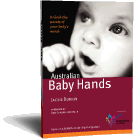Substituting Words In Baby Sign Language
Many parents have their own words that they prefer to use with their baby in certain situations such as meal times, breastfeeding, bedtime etc.
When using basic sign language to communicate with babies, where it is important to say the word at the same time as doing the sign, some parents will substitute the word that is associated with a particular sign for their own preferred word.
For example when approaching meal time the sign for “eat” may be used but the spoken word used in association with the sign may be substituted by the parent for their preferred word such as “din-dins”
The question arises as to whether or not this is good practice to substitute words which are not necessarily the correct correlating word with the sign.
When using a baby sign program such as Australian Baby Hands which uses Auslan, Australian Sign Language, the words associated with the sign are the correct ones for those signs.
Auslan is a language all of its own and by substituting words and relating them to a particular sign it is no longer proper Auslan.
But, we are talking about baby sign language here and as a busy parent it is important we remember that while trying to use Auslan we must also make this a fun and easy experience for you and your baby.
As with the example for the sign “eat” then substituting the word “din-dins” may be acceptable as the end result achieved will be that your baby understands that food is involved with this sign.
However substituting the word “hungry” while doing the sign for “eat” is not the same since there is quite a different sign for “hungry” than the sign for “eat”.
There may be situations with signs and words where a substitution for the correct word with the sign is perfectly acceptable. One particular example is “breast feed”, many mothers have their own word they prefer to use such as “num-nums”.
Wherever possible try to use the correct word associated with the sign as this will help to advance your baby’s speech development.
It is important to remember again that Auslan is a proper language.
By using incorrect, made up or modified signs you are changing the language of the Deaf Community. In some cases this has caused upset and even outrage among the Deaf Community such as a recent story in the press where a British children’s TV presenter opened the show by signing “I’m happy to see you” incorrectly which was translated into a rude sentence containing swear words.
So how strict do we need to be?
Living in Australia I feel that it is important that we respect the language of our Deaf Community and try to use Auslan as best we can.
Baby sign language is a bridging gap for communication while your infant is preverbal so even if you are not planning on further study in Auslan than learning some simple signs for words that will help make you and your babies life easier such as “eat”, “drink”, milk, “more” should be easy enough to stick to using correct Auslan.
Even stringing together two to three word sentences as your baby grows such as “more drink please”, can be simply done while sticking to the correct word and the correct sign.
It is unlikely that your baby will get signs 100% correct as their co-ordination levels take time to adapt to any new task at hand. This is ok. Praise your baby’s attempts and re-enforce the sign back to them. Repetition is key to helping babies learn any new skill and baby sign language is no different. With praise and repetition as your baby’s co-ordination skills improve so will their ability to communicate through sign.
To help develop language acquisition using the correct word and encouraging your baby’s initial efforts can help advance their vocabulary. It is important to listen to your baby, praise them and then re-enforce the correct word by speaking back to them slowly and patiently. Speech patterns develop over time and using baby sign language while saying the spoken word helps develop synapses between the right and left hemispheres of the brain.
For more information on how to help develop your baby’s speech you might like to read a little help on the road to talking.
Remember, it is not a test. Using baby sign language should be fun for you and you baby. By using Auslan we support and respect the language of the Deaf Community in Australia and hopefully we may help to bridge even more communication gaps around the country.
Happy Signing and as always, have fun! ?
- Please feel free to re-publish this article on your website including the authors bio details below in full.
Article written by Jackie Durnin:
Jackie Durnin shares more information on how to sign with your baby at her website https://www.australianbabyhands.com. Download a free chart of the six most common baby signs.
